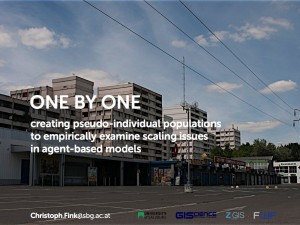At the European Colloquium for Theoretical and Quantitative Geography (ECTQG) 2013 I presented the methodology of the first work package of my dissertation. The exact procedure is explained in a bit more detail in another post on a poster explaining the same work package.
This is the abstract I sent nearly half a year ago:
CREATING PSEUDO-INDIVIDUAL POPULATIONS as an input for empirically examining scaling issues in agent-based models
Temporal, spatial, and social scaling has always been a controversial topic for scholars working with social simulation models. Going along the lines of Squazzoni (2012:xiii), the level of analysis is determining much more than only a model’s level of detail. Bottom-up approaches try to inductively gather knowledge about macro-level patterns from micro-level actions. Top-down approaches, on the other hand, attempt to deductively explain how macro-patterns impact individual interactions. Still, we do not know very much about the influences of scale and scaling on social models (cf. e.g. Easterling & Polsky 2004, Swyngedouw 2004, Carson & Koch 2013).
The current research is the first step in an ongoing project which aims to closer examine said influences of temporal, spatial and social scaling in an urban residential model. A prerequisite to run the closely supervised and rigorously documented series of simulations, which also will take a closer look on the interaction of independent scaling of different model dimensions, is a data basis with the highest resolution which is meaningful for the respective research questions (subsequently data is step-wisely aggregated). In the case of a residential model, individuals/households and dwelling units are the adequate reference units.
The core of the current research is a suite of custom Python scripts which make use of the GDAL/ORG library and the bindings for R. As input data, building polygons, a small-meshed population count grid, and various socio-economic variables on the basis of census tracts are used; currently data from France and Austria are processed. First, the population is distributed among buildings; a simple inverse distance weighting (IDW) algorithm smoothes sharp boundaries, a local dynamic threshold excludes non-residential buildings. Next, so household sizes are available, inhabitants are grouped to households. Finally, socio-economic variables are assigned to individuals, their distribution is weighted according to the neighbouring census tracts.
As a result, a vector dataset with individual inhabitants grouped into households and assigned to geo- referenced buildings is created. To verify the results, a re-aggregation is carried out; privacy and licensing issues are discussed.
KEYWORDS: Agent-based modelling, social simulation, data preparation, artificial population, geo-statistics
REFERENCES
Carson, D. B. & Koch, A., 2013 : Divining the local: Mobility, scale and fragmented development. Local Economy (forthcoming issue).
Easterling, W. E. & Polsky, C., 2004 : Crossing the Divide: Linking Global and Local Scales in Human– Environment Systems, in: Sheppard, E. & McMaster, R. B. (Eds.), Scale and Geographic Inquiry: Nature, Society, and Method, Malden, Oxford, Carlton: Blackwell, pp. 67–85.
Squazzoni, F. ,2012 : Agent-Based Computational Sociology, Chichester: Wiley.
Swyngedouw, E., 2004 : Scaled Geographies: Nature, Place, and the Politics of Scale, in: Sheppard, E. & McMaster, R. B. (Eds.), Scale and Geographic Inquiry: Nature, Society, and Method, Malden, Oxford, Carlton: Blackwell, pp. 129–153.
As it happens, it was accepted as is. Even more surprisingly, I managed to finish in time what I had promised half a year before.
You can find my slides here (as html) and here (as pdf).
